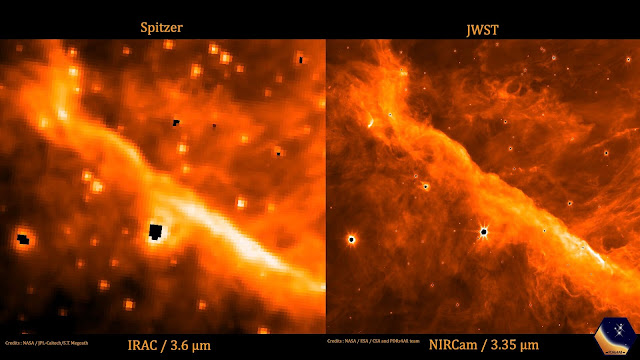The dense gas and dust wall resembles a gigantic winged creature, with its burning jaws illuminated by a bright star as it soars through cosmic filaments.
The first photographs of the Orion Nebula taken with the James Webb Space Telescope were released on Monday by an international study team, leaving astronomers "blown away."
The star nursery is located in the constellation Orion, 1,350 light-years from Earth, in a similar environment to that in which our own solar system was born more than 4.5 billion years ago.
Astronomers are interested in the region to learn more about what happened during our planet's first million years.
The photographs were obtained through the Early Release Science initiative, which engaged over 100 scientists from 18 nations, including the French National Center for Scientific Research (CNRS), Western University in Canada, and the University of Michigan.
"We are blown away by the breathtaking images of the Orion Nebula," Western University astrophysicist Els Peeters said in a statement.
"These new observations allow us to better understand how massive stars transform the gas and dust cloud in which they are born," she added.
Large volumes of dust hide nebulas, making them impossible to examine with visible light observatories like the Hubble Space Telescope, Webb's predecessor.
Webb, on the other hand, works predominantly in the infrared band, penetrating the dust.
This revealed a plethora of amazing structures on a scale of 40 astronomical units, or the size of our solar system.
These include dense matter filaments that could give birth to new generations of stars, as well as stellar systems composed of a central proto-star surrounded by a disc of dust and gas in which planets develop.
"We hope to gain understanding about the entire cycle of star birth," said Edwin Bergin, University of Michigan chair of astronomy and a member of the international research team.
"In this image we are looking at this cycle where the first generation of stars is essentially irradiating the material for the next generation. The incredible structures we observe will detail how the feedback cycle of stellar birth occurs in our galaxy and beyond."
Webb is the most powerful space telescope ever built, with a 6.5-meter (more than 21-foot) primary mirror made up of 18 hexagonal, gold-coated segments and a five-layer sunshield the size of a tennis court.





Top best earnings tools and many more must check
ReplyDeleteIm taking your sustenance in addition, Thanks
ReplyDeleteI was very impressed when I found your writing. I'll come back often after bookmarking
ReplyDeletethanks for sharing this type of useful articles to read.
ReplyDeleteEasily, the article is actually the best topic on this registry related issue.
ReplyDelete